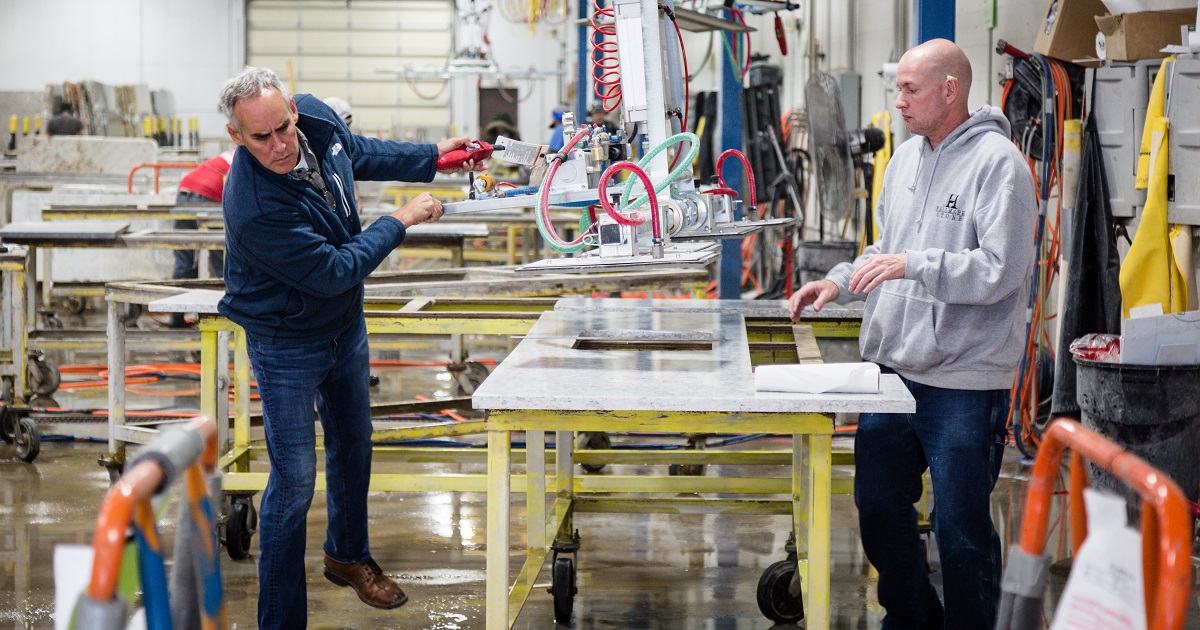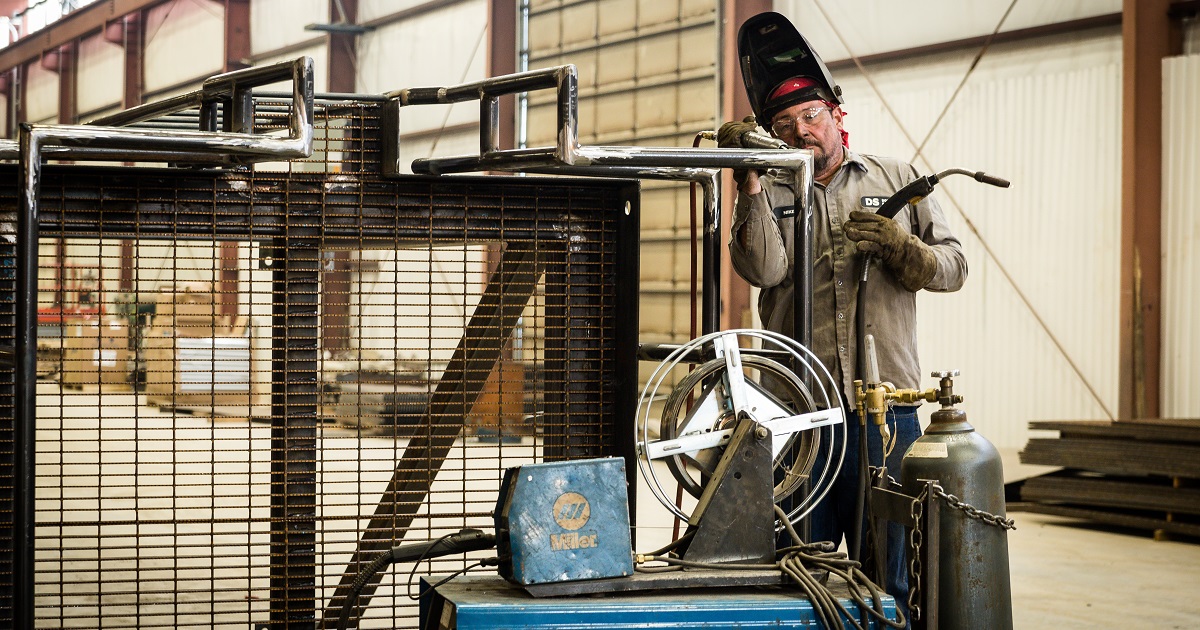For Media Inquiries
Contact Revee White, Director of Marketing and Communications at rwhite1@mem-ins.com or 573.499.4190.
A solid workplace safety program benefits your business in many ways. It protects your most important asset: your people. A safety program can also help you reduce your work comp premium by preventing injuries and managing claim costs.
Why you need a workplace safety program
Workers compensation insurance is the most commonly accessed line of insurance. Work-related injuries are both common and expensive. According to data from Missouri Employers Mutual, the average cost of a lost-time claim is about $54,000. Claim costs alone can be difficult for a business to overcome, and workplace injuries come with additional hidden costs like lost productivity, investment in new employees, damaged reputation and reduced employee engagement.
For most businesses, having a work comp policy is required – and most of them want to know how they can lower their premium. There’s no trick. The simple truth is: You can reduce your premium by improving workplace safety and preventing injuries. You can also impact premium by having an injury management plan in place to treat employees and manage costs if an injury does occur.
Whether you’re just getting started or planning improvements to your existing program, focus on these four foundational elements. Watch the video or continuing reading for all the details.
The four key aspects of a workplace safety program
For your program to be successful, you must have:
- A strong dedication to safety from top management in policy, words and actions
- An understanding of current costs and how injuries affect capital
- Proactive tactics to prevent employee injuries
- Reactive tactics including an injury management plan

Here’s a deeper dive into each of these aspects, including lots of links to the resources you’ll need to take action.

1. Top managers must believe in safety
Safety efforts will fail without real support from an organization’s leadership. Management must be willing to stand behind your safety program and allocate resources to support it. Start by finding a safety champion on your company’s leadership team (or maybe you are the champion).
Then, work together to get the buy-in you need. Leadership must be prepared to create safety policies and enforce them with disciplinary action if they’re broken.
Support your workplace safety program financially
It’s as simple as cash. Personal protective gear, safer machines and better equipment cost money. You don’t have to allocate millions to your safety program on day one – but your plan should include a budget. Behaviors are an important part of workplace safety, and so are tools. Every business has an opportunity to invest in safety, whether it’s PPE, machinery or facilities.
Support your safety teams and advocates
Safety teams can be sensitive to both failure and success – after all, we’re talking about saving lives. If the team isn’t making progress on safety improvements, it may fizzle out. If you hire a safety professional or assemble a safety committee, be prepared to act on their recommendations. Remember, this might require an investment. Communicate your support and if a change isn’t possible right away, come up with a clear plan for future improvements.
Enforce your disciplinary policies, and show appreciation to employees who are working safely. What’s more expensive – an employee who follows safety protocol, or one who’s injured? Rewards like special lunches and reasonable gifts are small costs that pay a big return by positively reinforcing safe work behaviors.

2. Understand the costs of neglecting safety
Neglecting workplace safety can result in the ultimate cost – one of your employees could be seriously injured or killed. It’s also important to understand the financial costs associated with your work comp policy and how your workplace safety programs affect them.
Know where you stand
What are you currently paying for work comp insurance? Don’t just think of it as a bill. Build strong relationships with your agent and your carrier. They want the same thing you do: to prevent workplace injuries and keep claim costs low. Your agent and insurance provider can make recommendations and offer services to reduce your risk and save you money after a claim.
They can also help you understand how to lower your premium by improving safety and claims management. For example, your carrier might have avenues for you to earn money back for proven safety programs, like MEM’s Safety Grant program.
Finally, you should know your experience modifier rate (EMR) and talk to your carrier about how to reduce it. How low could you get it? For interesting conversation, how high could it go? A low EMR will result in savings for your company.
Consider your claims history – and future
How many claims has your company had in the past five – or ten – years? What were the causes and how much did they cost? Conduct incident investigations after every injury and take steps to prevent those risks in the future.

3. Proactively prevent employee injuries
Workplace safety doesn’t just happen (and it isn’t common sense!). It takes real effort. Your staff must devote energy to implementing workplace safety programs from conceptualization to job site.
Safety meetings and training
Hold safety meetings on a regular basis aimed at increasing employees’ awareness of pertinent safety issues. Documentation is key – keep records of when you held meetings, what you discussed and who attended.
Most companies also need some machine- and job-specific safety training. Your employees must have focused, documented training on specialized equipment and machines, like presses, saws and forklifts.
Safety inspections
Create a schedule for regular inspection of work areas, machines and equipment. Inspections are a great way to find hazards before they find your employees! Check out your job sites during the work day. Do all employees have the required safety gear? Are they exposed to dangerous mechanical hazards or slippery conditions that could lead to a fall?
Again, document your activity. How long has it been since someone inspected XYZ machine? If you don’t know – to the date – either it’s been too long, or you’ve done a poor job of documenting your safety inspections.
Safety policies and rules
Your safety policies will be most effective if they’re set in stone – written and signed by every employee at your company. This includes the rules and the disciplinary consequences for breaking them. Hold employees accountable when you discover unsafe acts or conditions. Be sure to enforce the rules fairly and consistently.
Here are some sample policies to get you started:
In some situations, safety infractions that result in injuries could mean that a penalty is applied to the injured worker, cutting their work comp benefits by as much as 50%. Make sure employees understand that penalties could apply to them and they can avoid them by following written safety rules.

4. Prepare to manage injuries that do happen
An injury management plan helps you ensure that an injured employee receives quality care while controlling medical costs. If you don’t have an injury management plan, your work comp carrier can help you develop one.
Injury reporting
Provide training to all managers so that they understand their responsibilities in case of an employee injury. Have an injury reporting policy that employees must report all injuries in writing before leaving work for the day. In turn, your business should seek to report all injuries to your insurance carrier within 24 hours.
Prompt injury reporting is crucial to getting your employee the right level of care as quickly as possible. It also helps control claim costs. Your claims representative is an expert and will help you use all the carrier’s resources to treat the employee while managing costs.
Directed medical care
Employers’ rights to direct medical care vary by state; your insurance carrier will know your state’s laws and can answer any questions. To the extent that you can, you should direct your employees’ medical care in case of workplace injury. If you can’t legally direct care, you can still recommend medical providers if the employee asks. They may not know where to start and come to you for a suggestion.
Find top-quality treating physicians and clinics that understand the work comp system. Your insurance carrier likely has a trusted network of providers and can make suggestions if you ask. Often, you can achieve savings on medical costs by seeking medical treatment within your carrier’s network.
Drug and alcohol testing
Perform post-injury drug and alcohol testing on your employee within 24 hours of any injury that requires treatment. Drug screening is a commonly misunderstood topic – one we discussed at length on our Drugs and Alcohol in the Workplace podcast episode.
Have a detailed substance use policy that outlines which types of testing you will perform, under what circumstances. If your employees are aware of your policy, and you apply it fairly and consistently, it’s one of the best ways to reduce the risk of an impaired worker endangering the rest of your team.
Transitional or light duty work
Offer light duty options for employees who’ve missed work due to an injury. Returning to work with modified job duties helps your employee maintain their routine, be productive and recover faster. In addition, if the employee is performing light duty while recovering, the National Council on Compensation Insurance will give you a 70% reduction in how those claims costs factor into your EMR. This is great news for the claim’s impact on your future premium.
Communicate, communicate, communicate
Keep open communication with your injured worker and your insurance carrier often. Make sure everyone understands what’s going on and what their responsibilities are. Don’t withhold information. Transparency is key to avoiding misunderstandings that complicate the process or create ill will where none was intended.
Create or improve your workplace safety program today
For businesses of any size, an effective safety program begins with talking to your employees about safety, developing written plans, and promptly reporting injuries to your insurance carrier. Take some time to evaluate your safety efforts. How do you stack up in these four foundational components? You can significantly reduce your risk of injury by getting these into place.
If you’re ready to take your workplace safety program to the next level, contact our Safety and Risk Services team.
